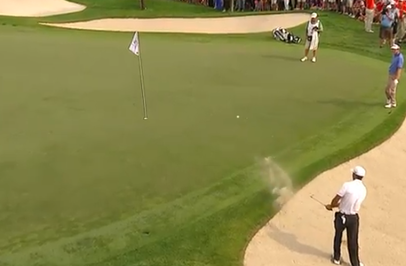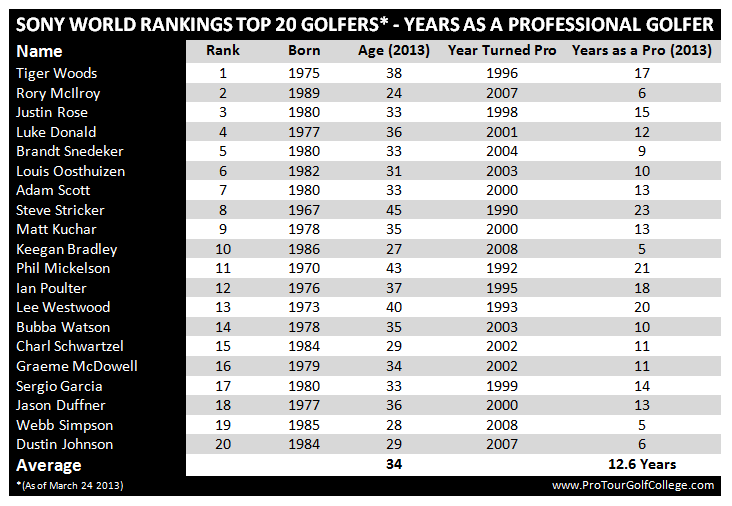 Ok so you want to learn how to be a pro golfer. You watch golf on television every week and watch PGA and LPGA tour players battling it out for huge purses and you want to be part of it. Well good for you! But before we begin, and just to be clear, what you want is to make your living playing in golf tournaments for prize money right? This is quite different from becoming a golf professional who works in the golf industry as either a golf instructor/coach, golf shop retailer or in some aspect of golf club management. In our article today we’re talking primarily to golfers who want to learn how to be a pro golfer - who want to travel and compete for prize money, and get good enough to play on a major professional golf tour. Professional golfers are a growth industry and many young male and female golfers from every corner of the world are now considering this career choice over many others. And I do mean career choice, as any golfer contemplating a life as a professional golfer must realize that you have to be in it for the long haul. What do I mean when I say long haul? You'll find out by reading on. To be a professional golfer you have to love golf and the idea of competing in tournaments so much that you will devote a large part of your life to it. This is not a decision to take lightly as the failure rate is extremely high in professional golf mostly because of the lack of information and education available that will help you to make an informed decision.  Preparation + Hard Work Will Trump Talent “If comfort is your goal, your next level of success is not in your future.” – Bill Bachrach Let me be clear up front with you that the failure rate on professional golf tours is not so much because of the lack of ‘talent’ of individuals (which is a very convenient excuse for why so many fail). Its much more about the meticulous preparation and hours you need to invest each and every day into your golf practice and play-well before you change your status from amateur golfer to professional golfer. Yes you have to have a very high playing standard to make money on the men’s and women’s professional golf tours but this has a lot more to do with the management of your game in the development years leading up to the time you make the choice to compete professionally. You have to manage your game so that you can continually lower your competitive score average even when your golf scores are already around par or better. Fortunately that is where we come in. At Pro Tour Golf College we’re in the business of educating amateur golfers about how to become a pro golfer and what is required to make the leap from amateur golfer to professional golfer as smoothly and easily as possible.  Step 1. Get Your True Golf Handicap Down Your true golf score average is your golf score against par, with every score you produce in golf tournaments counted. Yep, you have to put every card on the table as you’re developing your game-not just your best score cards. The year that you decide to turn pro you will have achieved a score average in important amateur tournaments of 71 or better. You will need a score average at least this low to be able to make the cuts in the pro tournaments you play in, and anything higher than this will mean that you won’t make any money, but it will cost you plenty! The amateur handicapping system will be your biggest handicap if you just put your best cards in. Don’t practice this bad habit that we see is an accepted practice in amateur golf. We don’t care what your amateur ranking is; but we do care what your competitive score average is. You have to count every golf score you have in amateur golf tournaments (good or bad) and anything less than this and you’re kidding yourself about becoming a successful professional golfer, as the professional golf tours only pay you when you produce consistent low scores. If you practice only putting your best score cards in to get your handicap down and your ranking up, then this will catch up with you later on. Your responsibility and that of your golf instructor/coach is to keep developing ways to lower your true competitive score average, and this is the biggest challenge you will face in becoming a competitive professional golfer. You need to build golf practice systems that drive your golf scores down, and you also need to be patient enough to give these systems time to work for you. Have a look at the following image showing Tiger Woods competitive score average over ten years (2003 – 2013) and note his consistency from year to year, and notice more importantly how he is able to keep bringing his score average down when it bumps upwards. He is now in his late-thirties and is still working hard to push his actual score average down so he can win golf tournaments. I ask you to take particular notice of how Tiger has lowered his competitive score average by 1.89 strokes per round from 2010 (70.77) to 2013 (68.88). This is his true ability in golf and what makes him arguably the greatest golfer ever!  Step 2. Get Professional Help If you’re serious about learning how to become a pro golfer then don’t make the mistake that many young amateur golfers make and try to do it all on your own. It is not enough to put long hours of practice in to develop your game, you need professional help (especially in your mid-teens) from trained and experienced PGA and LPGA instructors who are dedicated to helping you build a strong golf performance platform well before you turn professional. This requires that you get coaching on a weekly basis from professional golf instructors who have lots of experience working with elite golfers. We are not talking about basic golf instruction, what we’re talking about is advanced golf instruction with detailed long term training plans and systems for developing your golf skills and playing ability to a very high standard.
What you don’t want to do in your first cycle is to take golf instruction advice from well-meaning club members or even your relatives who have little to no experience working with advanced golfers. This will not help you, and is likely to set you backwards with your golf development.  Step 3. Four Year Planning and Development Cycles Olympic coaches work in four year cycles and so should you as this will help to lay out your long-term pathway to golf improvement. By thinking of your first development cycle as four years (16 to 20) you can focus on yourself so you can develop and improve your golf skills, playing ability and lower your score average, and worry less about what the other junior golfers in your age bracket are doing. This is a big problem for many young golfers and their parents where they compare their performances in golf tournaments against others instead of focusing on a long term plan of gradual improvement. Our studies of top professional golfers show that in most cases they develop into top level professional golfers after a minimum of two cycles of four years. This means that once you get onto a professional golf tour it is likely to take you up to four years to start making regular checks and another four years to start contending in - and winning golf tournaments. Study our images below to understand what we mean. Notice in every example below how we have the preparation and development cycles which lead into the competitive phases? It doesn't matter when you start, the point is that you start and realize that it will take longer than you think to become a pro golfer, who can make money consistently on a professional golf tour. In the first image we call the this young champions pathway which explains how the Tiger Woods, Rory McIlroy and Rio Ishikawa and Lexi Thompson got so good at such a young age. In this example they all turned pro in the third cycle and won tournaments pretty quickly. The thing to understand here is that in every case the young champions already have years of competition and experience by the time they turn pro. They just specialized at a much earlier age than most. (Click on the images to make them larger) Notice that we describe the first cycle as your preparation and development cycle. This is the cycle where you work hard with your golf instructor on turning your long-game, short-game and putting skills into solid habits, and it is also where you will experience the most improvement in your score average over the three cycles. Eight years of professional golf before you reach world class is not unusual; but we have found that the majority of amateur and professional golfers never think this far in advance. Our argument is that to play golf at such a high standard requires many years of planning and dedication, and trying to force yourself to become a top level golfer in the short-term is probably going to hold you back. If you find it hard to believe that it can take 8 years or longer then take a look at the following image showing the top 20 ranked golfers in the world (As of March 24) and their average years as a professional golfer is 12.6 years. Just 5 of these golfers have been a professional for less than 10 years. Next week we'll continue with steps 4 to 7 of "How to Be a Pro Golfer: The 7 Steps You Must Take to Make it."
So thanks for reading and we hope you enjoyed it. Lawrie Montague and David Milne - Pro Tour Golf College Your Success On Tour is Our Business 3/4/2013 12:36:58 am
Thanks so much for your feedback Robert. I agree, there's nothing more honest than simple - straight forward facts. That's our mission with our blog, tell it the way it is. Comments are closed.
|
Archives
June 2019
|
Proudly Supported By
Copyright © 2011 - 2018 Pro Tour Golf College
Website Managed By Golf Performance Media
All Rights Reserved
Website Managed By Golf Performance Media
All Rights Reserved







 RSS Feed
RSS Feed



